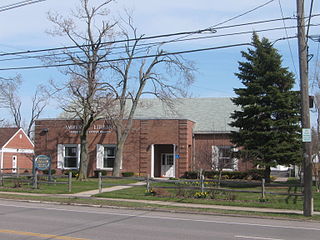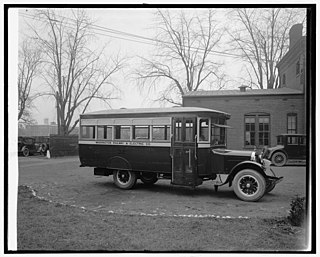
Hornell is a city in Steuben County, New York, United States. The population was 8,259 at the 2020 census. The city is named after the Hornell family, early settlers.

The New York Central Railroad was a railroad primarily operating in the Great Lakes and Mid-Atlantic regions of the United States. The railroad primarily connected greater New York and Boston in the east with Chicago and St. Louis in the Midwest, along with the intermediate cities of Albany, Buffalo, Cleveland, Cincinnati, Detroit, Rochester and Syracuse. New York Central was headquartered in New York City's New York Central Building, adjacent to its largest station, Grand Central Terminal.

Streetcars in Washington, D.C. transported people across the city and region from 1862 until 1962.

New York State Route 33 (NY 33) is an east–west state highway in western New York in the United States. The route extends for just under 70 miles (113 km) from NY 5 in Buffalo in the west to NY 31 in Rochester in the east. It is, in fact, the only state highway that directly connects both cities, although it is rarely used today for that purpose. The westernmost 10 miles (16 km) of NY 33 in Buffalo and the neighboring town of Cheektowaga have been upgraded into the Kensington Expressway. This section of NY 33 is one of several freeways leading out of downtown and serves as a main route to the Buffalo Niagara International Airport.

Snyder is a hamlet within the town of Amherst in Erie County, New York, that is part of the Buffalo–Niagara Falls metropolitan area. The hamlet was established in 1837. It was named for Michael Snyder, its first postmaster, who also operated a store at the corner of Harlem Road, which is also known as New York State Route 240, and Main Street, which is also known as New York State Route 5. The hamlet blossomed due to retail activity demand created along the Main Street transportation route between Buffalo and points to the east in the 19th and early 20th century.

The Texas Electric Railway is a historic interurban railroad that operated from Dallas, Texas, to Denison, Corsicana, and Waco. It began operation in 1908 and through the merger of several companies became the largest interurban railway operator in the South before its demise in 1948.

The Phoenix Street Railway provided streetcar service in Phoenix, Arizona, United States, from 1888 to 1948. The motto was "Ride a Mile and Smile the While."
The Sand Springs Railway is a class III railroad operating in Oklahoma. It was originally formed in 1911 by industrialist Charles Page to connect his newly formed city of Sand Springs to Tulsa, operating both as a passenger carrying interurban and a freight carrier. At Sand Springs, the company also served his children's home, and Page directed all railroad profits to support the home's operations.
The Tonawanda Railroad was a railroad company established in Rochester, New York in 1832. It was eventually absorbed by the New York Central.

Transportation in Tulsa, Oklahoma includes a bus network and a system of raised highways and primary thoroughfares, laid out in mile-by-mile increments. In addition, throughout its entire length in Tulsa, historic Route 66 is a drivable road, with motels and restaurants reminiscent of the route's heyday era.

The Washington Railway and Electric Company (WRECo) was the larger of the two major streetcar companies in Washington, D.C., and its Maryland suburbs in the early decades of the 20th century.
Michigan United Railways (MUR) was an interurban which owned and leased numerous lines in the state of Michigan during the early twentieth century.

The New York Museum of Transportation (NYMT), founded in 1975, is a non-profit organization located at 6393 East River Road, in the Rochester suburb of Rush. A private rail line built by volunteers connects NYMT with the Rochester & Genesee Valley Railroad Museum, over a distance of two miles. This demonstration railway allows both museums to offer train rides with their collections of vintage railroad equipment. NYMT operates the only electric trolley ride in New York State, not to be confused with the similarly named Trolley Museum of New York located in Kingston, New York.

The Charlottesville and Albemarle Railway (C&A) was a short electric street railroad operating within the city of Charlottesville, Virginia, United States, during the early 20th century. The line was preceded by several streetcar lines operating both horse-drawn and electric powered cars dating back to 1887. After facing financial difficulties, the predecessor lines were reorganized into the C&A in 1903. The C&A's electric streetcars operated off of an overhead line system that was powered by the railroad's own power plant. The C&A also offered electric power generated by its plant to the city of Charlottesville. During the mid-1910s, the line received numerous upgrades, including the construction of a new power plant on the Rivanna River, a new company headquarters building, expansion of track, and the purchase of new streetcars.
The Rochester, Lockport and Buffalo Railroad was an electric interurban railway that was constructed between Rochester, New York, and Lockport, New York, connecting to the International Railway Co. at Lockport for service into Buffalo. Opened in 1909 as the Buffalo, Lockport and Rochester Railway, the route followed the Erie Canal and the New York Central Railroad's Falls Road branch for most of its length. The direct route took a little over two hours to travel from Lockport from Rochester. Most trains were local routes and took 2 hours 35 minutes. There were trains between the main stations every hour, however there were trains between Rochester and Brockport every 30 minutes and sometimes every 15 minutes. For a brief period of time, the railway was part of the Beebe Syndicate of affiliated interurban railways stretching from Syracuse to Buffalo. Entering receivership in 1917, it was reorganized as the Rochester, Lockport and Buffalo Railroad in 1919. After years of struggling with declining revenue during the Depression years, the railway's last day of service was April 30, 1931.
The Rochester Railway Company operated a streetcar transit system throughout the city of Rochester from 1890 until its acquisition by Rochester Transit Corp. in 1938. Formed by a group of Pittsburgh investors, the Rochester Railway Company purchased the Rochester City & Brighton Railroad in 1890, followed by a lease of the Rochester Electric Railway in 1894. The Rochester and Suburban Railway was leased in 1905, extending the system's reach to Irondequoit and Sea Breeze. Rochester Railways was acquired by the Mohawk Valley Company, a subsidiary of the New York Central Railroad set up to take control of electric railways in its territory. In 1909 the holdings of the Mohawk Valley Company were consolidated as the New York State Railways.
Chartered in 1904 by the Beebe Syndicate, the Auburn and Northern Electric Railroad connected the city of Auburn, New York with the Rochester, Syracuse and Eastern Railroad at Port Byron, New York to the north. The New York Board of Railroad Commissioners authorized construction and a $1 million mortgage to the A&N in 1905 so it could build 12 miles (19 km) of track between Auburn and Port Byron. Lease of the line to be used by A&N was negotiated at an Auburn and Syracuse Electric Railroad stockholders' meeting in May 1907.
The Hornell Traction Company was an electric streetcar company serving Hornell and Canisteo, New York, between 1892 and 1926.










